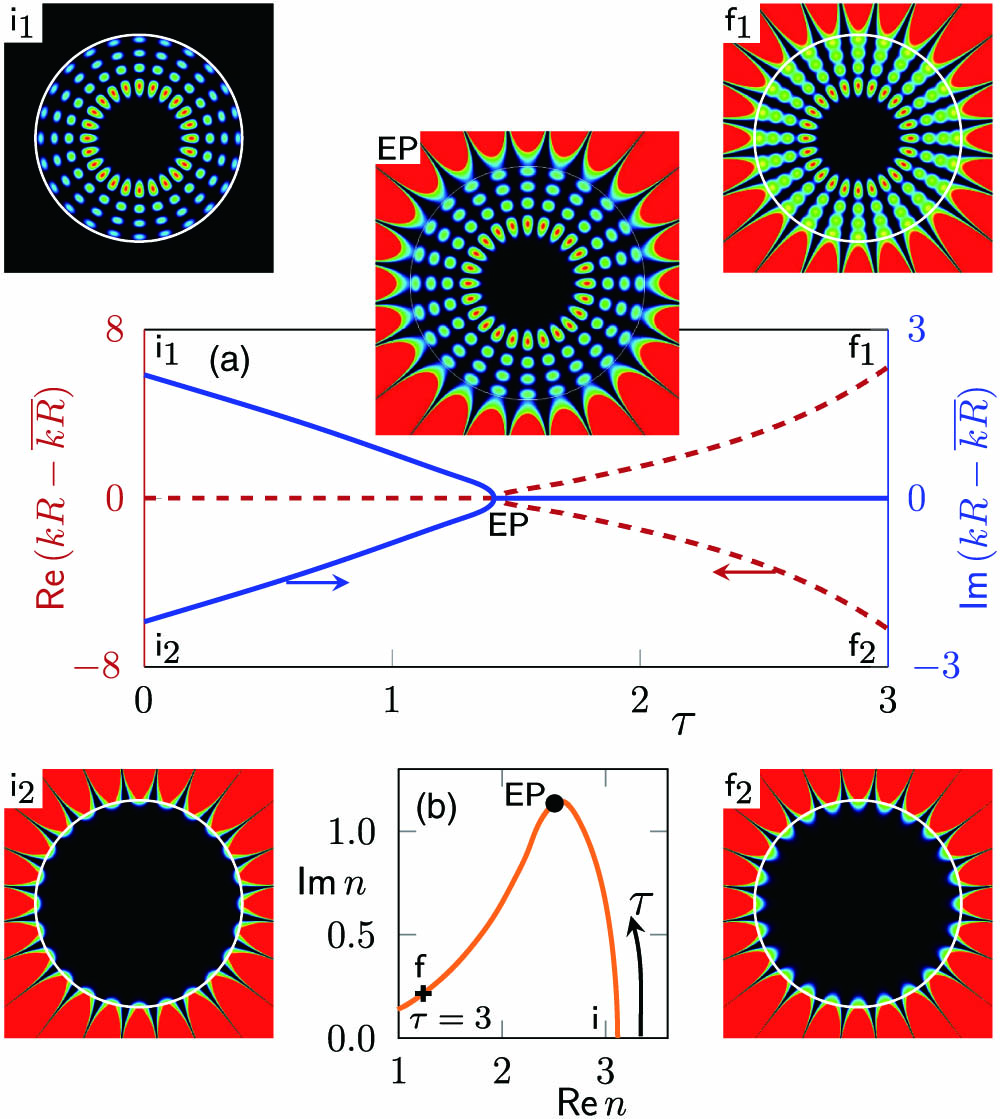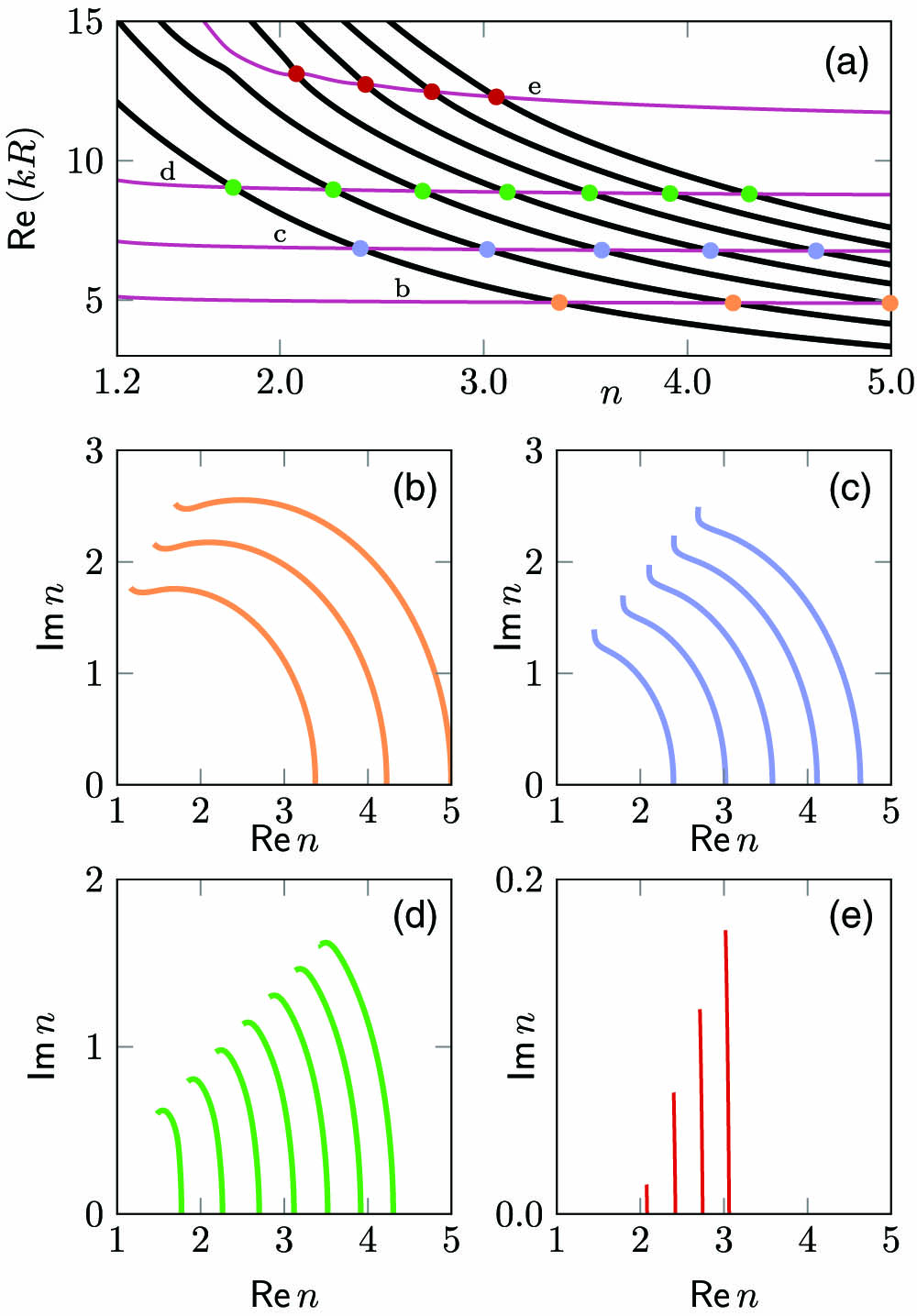Non-Hermitian degeneracies of internal–external mode pairs in dielectric microdisks
1. INTRODUCTION
Openness is a generic property of realistic quantum and wave systems. Hence, their dynamics is in general described by a non-Hermitian Hamiltonian with complex eigenvalues. An interesting feature of this non-Hermitian physics is the exceptional point (EP) in parameter space where both the eigenvalues (complex frequencies) and the corresponding eigenstates (modes) coalesce [13" target="_self" style="display: inline;">–
Optical microdisk cavities are ideal model systems to study non-Hermitian physics [20]. In recent years, it was demonstrated that EPs in microcavities can be caused by several mechanisms, e.g., by boundary deformations [12,21–
Along with the internal modes, there is another class of optical modes known as “external modes,” which have a large decay rate and almost no intensity inside the cavity. The internal and external modes have been classified in previous studies [2830" target="_self" style="display: inline;">–
In spite of the pioneer works proving the interactions between internal and external modes [30], there have been no investigations conceiving the possibility of EPs associated with external modes. Therefore, the aim of this paper is to reveal the existence of such EPs involving internal and external mode pairs. To demonstrate this, we introduce two kinds of systematic perturbations of a circular cavity: (i) a deformation of the cavity’s boundary, and (ii) an absorbing material.
The paper is organized as follows. In Section
2. MODES IN THE DIELECTRIC MICRODISK
For the convenience of the reader, we repeat some known facts of optical modes in quasi-two-dimensional microdisks [20]. The damped time-harmonic solutions of Maxwell’s equations in the dielectric microdisk cavity with effective refractive index
Through the separation of variables in polar coordinates, the optical modes in the circular cavity with radius
Figure

Fig. 1. (a) Real and (b) imaginary part of scaled frequency 1 ) for TE polarization with
3. WEAK AND STRONG COUPLING OF MODES IN CIRCULAR CAVITIES
In this section, we consider a circular cavity with a real-valued refractive index

Fig. 2. Degree of degeneracy of mode pairs 3 ) as a function of azimuthal mode number
It is an interesting fact that even in the circular cavity, signatures of an EP can be observed in the parameter space spanned by the real-valued refractive index and the radial mode number
The weak and strong coupling regimes are readily appreciable through a toy model of a non-Hermitian Hamiltonian where
In Fig.
![(a) Real and (b) imaginary part of kR in the circular cavity as a function of refractive index n with a fixed azimuthal mode number m=10 undergoing strong (i, ii) and weak [(iii, iv) and (v, vi)] coupling between k10BR and k10IR with different radial mode numbers l=3, 4, and 5. Solid-black and dashed-orange curves are k10BR and k10IR, respectively. Solid-blue arrows in (a) and (b) guide the trajectory of kmIR for increasing n. Dotted-blue vertical arrows indicate the change of a radial mode number l of kmIR (frequency of the nearest internal mode to the Brewster mode) from 3 to 4. The right panels show intensities |ψ(x,y)|2 of the modes marked by the same labels as in (a) and (b). The white-quarter circular and sky-blue oscillating curves superimposed on the right panels are the cavity boundaries and |ψ(x,0)|2, respectively.](/richHtml/prj/2019/7/4/04000464/img_003.jpg)
Fig. 3. (a) Real and (b) imaginary part of
Figure

Fig. 4. (a) Real and (b) imaginary part of
Up to now, the EPs in the circular cavity, with real-valued refractive index
4. DEFORMED CAVITY WITH REAL-VALUED REFRACTIVE INDEX
We consider the microflower cavity [35,36] where
Since our goal is to efficiently couple the Brewster mode with frequency

Fig. 5. Illustration of the cavity boundary in Eq. (6 ) with
We calculate

Fig. 6. (a) Real and (b) imaginary part of the frequencies 3 . Orange curves connecting the points marked by numbers from 1 to 12 show the Riemann surface topology around the EP. Blue curves are the branch-cut in Eq. (7 ).

Fig. 7. Intensity mode pattern 6 with the same labels. The white circular and corrugated curves are the cavity boundaries.

Fig. 8. Intensity mode pattern 6 with the same labels. The white corrugated circular and sky-blue oscillating curves, superimposed on the figures, are the cavity boundaries and
In order to ascertain EPs embedded in the Riemann surface in Fig.
The general existence of the EPs of internal and external modes is exemplified in Fig.

Fig. 9. (a) Real and (b) imaginary part of the frequency relative to
5. CIRCULAR CAVITY WITH COMPLEX-VALUED REFRACTIVE INDEX
In the previous section, internal and external modes are tuned to cause an EP using a deformation of the cavity’s boundary. A crucial effect of such a deformation is the
In the following, we explain the scheme to derive an EP using a complex refractive index in detail. We consider as an example the internal mode

Fig. 10. (a),(c) and (b),(d) show the real and the imaginary parts of
In Fig.

Fig. 11. (a) Real (left/red axis/dashed curves) and imaginary (right/blue axis/solid curves) parts of the wave number
The general existence of such EPs for internal–external mode pairs, through the complex refractive index, is confirmed by exemplifying several mode pairs with

Fig. 12. In (a),
In obtaining EPs through the complex-valued refractive index, some remarks are in order. First, the tracing procedure starting from the crossings in the imaginary part of
At first glance, the experimental feasibility to adjust both the real and imaginary parts of the effective refractive index over wide ranges as, e.g., in Figs.
6. SUMMARY
We revealed numerically the existence of exceptional points resulting from the coupling of two different kinds of modes, i.e., an internal (Feshbach resonance) and external mode (shape resonance), in an optical microdisk cavity. The external modes have exponentially small contributions inside the cavity and a low
7 Acknowledgment
Acknowledgment. C.-H. Y. was financially supported by the DFG (project WI1986/7-1). M. H. and J. K. acknowledge support from DFG under the Emmy Noether Programme. The authors thank J. Kreismann for fruitful discussions.
[1]
[3] M. V. Berry. Physics of nonhermitian degeneracies. Czech. J. Phys., 2004, 54: 1039-1047.
[31]
[39]
Article Outline
Chang-Hwan Yi, Julius Kullig, Martina Hentschel, Jan Wiersig. Non-Hermitian degeneracies of internal–external mode pairs in dielectric microdisks[J]. Photonics Research, 2019, 7(4): 04000464.





